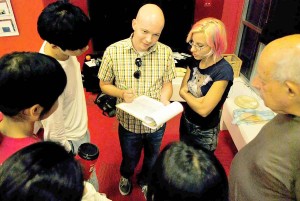Stevens Institute seeks to optimize federal research
The USC Stevens Institute for Innovation recently released a report that addresses appropriations for university research, a key point in Obama’s State of the Union speech last week.
[Correction: A previous version of this article said the report released by the USC Stevens Institute for Innovation addressed problems in university research. The report focuses on the role of university research in policymaking. The Daily Trojan regrets the error.]
The “Universities in Innovation Networks: The Role and Future Promise of University Research in U.S. Science and Economic Policymaking” is the fourth report in the Doing What Works and Science Progress projects at the Center for American Progress.

Innovation · The Annenberg Innovation Lab, which opened in fall 2011, is an example of innovative research occurring at USC, according to the Stevens Institute. - Chris Roman | Daily Trojan
Led by Vice Provost for Innovation and Executive Director of the USC Stevens Institute for Innovation Krisztina Holly, the report highlights the resources available at universities to stimulate growth and greater competitiveness for the country.
“Higher education plays a hugely important role in driving the economy,” Holly said. “Each year, universities get federal funding for research, and all of this can translate into products, companies and jobs.”
In the report, Holly addresses the ways in which federal policies and capacity for university research are tied together and outlines five recommendations to improve federal research and development policy so that universities can achieve their potential to spearhead innovation in key industries.
Melissa Lechner, a graduate student studying medicine in a PhD and MD program, said her work in cancer research can be attributed to the support she received from the university.
“The goal is to improve outcomes for patients,” Lechner said. “USC allowed me to take discoveries in basic science and translate it to patients in a rapid manner that wouldn’t have been possible on my own.”
Some of the challenges with the broader field of innovation involve measuring the impact, as it changes rapidly, and the perceived risk. But,as students try to prepare for the progressive workforce in this current economic and political climate, many are stepping up.
The USC Stevens Institute is just one of the many unique features at USC that are involved with promoting this innovation culture.
“These programs that are university-wide are aimed to nurture the culture of helping to transfer ideas to make an impact,” Holly said.
The USC Stevens Institute is also host of the USC Student Innovators Showcase during Trojan Family Weekend.
Ranging from projects on real-time cinema analysis of the presidential campaign to research on public interactive exhibits, the Annenberg Innovation Lab was created in 2009 to support students and faculty in their interdisciplinary efforts.
As the technology manager who works closely with student team projects, Dale MacDonald said, “The entity itself is an innovation and is going to lead to profound, transformative change along the way.”
Noting its charter to follow processes of innovation inspired by culture other than just technology, MacDonald encourages students to take advantage of opportunities like CRUNCH, the lab’s yearly design competition for USC students and alumni with a $30,000 prize.
Similarly, the Graduate Student Government hosts a yearly Poster Symposium that will soon include a website component to showcase innovative research done by USC graduate students across all departments and judged by USC faculty.
GSG Academic Affairs Director Jaclyn Selby, a graduate student studying global media and tech policy, said, “The point is so that people can see the best research at USC beyond what they know at their own department.”
If all it takes is an idea, students and faculty are right where they need to be to take advantage of some of the most forward thinking research and learning opportunities. Holly said there are many opportunities in Los Angeles.
“Keep your eyes open,” Holly said. “Students should be excited by the potential to work on the next new thing.”
